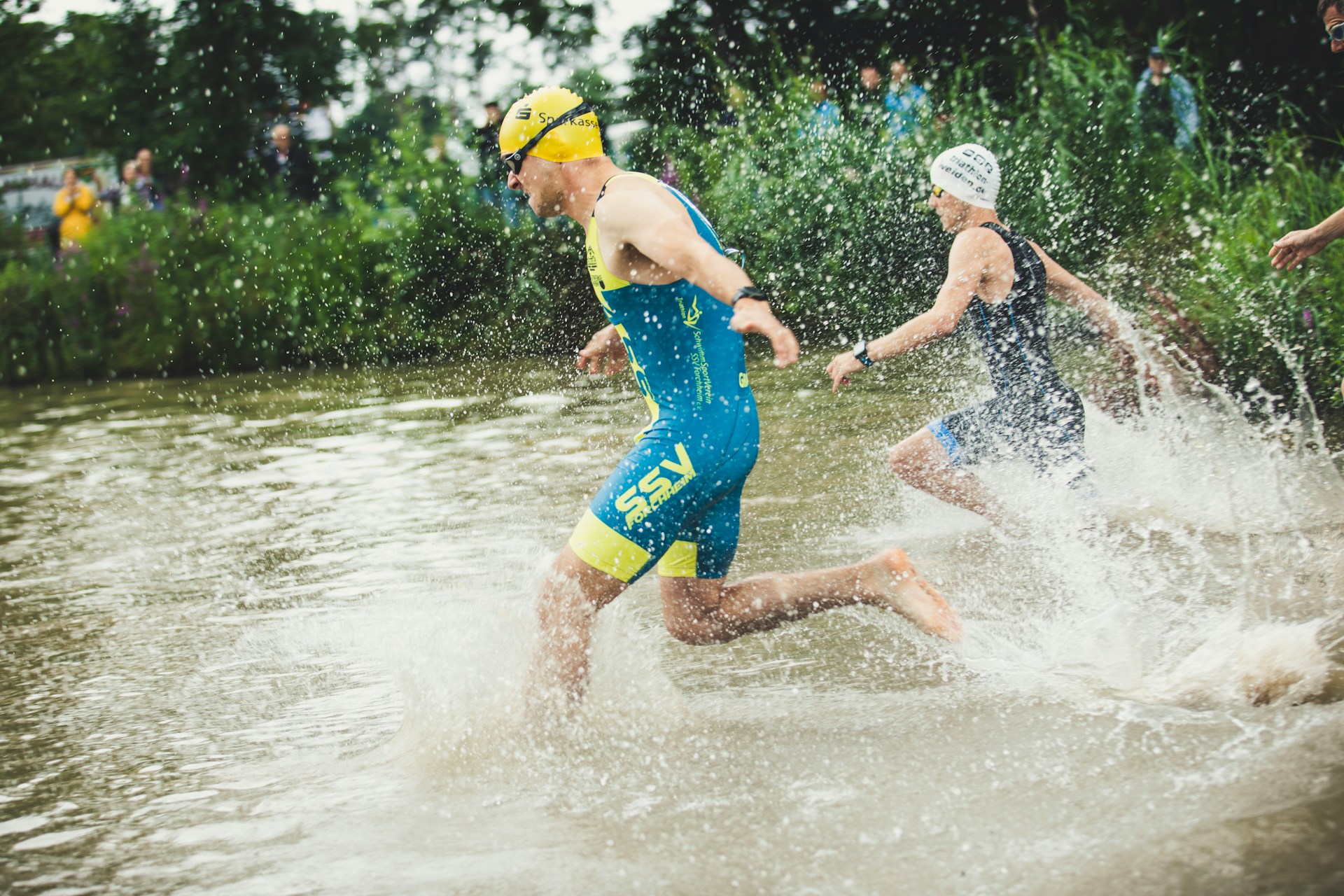Last Updated on January 25, 2024
Triathlon, a challenging and exhilarating multi-sport event, has captured the hearts of athletes worldwide.
Whether you’re a seasoned triathlete or a newcomer to this demanding world, mastering the specialized vocabulary of triathlon is crucial for successful training and competition. In this in-depth guide, we will delve into 24 essential triathlon terms, providing precise definitions and insights to empower you on your triathlon journey.
1. Transition (T1 and T2): Where Disciplines Converge
In triathlons, transitions are critical moments where athletes switch between disciplines, impacting overall performance. T1 denotes the shift from swimming to cycling, while T2 signifies the transition from cycling to running. Achieving mastery in these transitions is essential for enhancing efficiency and gaining a competitive edge in races. Athletes focus on strategic elements like laying out gear in a tidy manner, swiftly moving from one activity to another, and optimizing the setup in transition areas. These practices, combined with mental preparedness, contribute to a smoother and faster transition process, ultimately influencing the overall success of a triathlon performance.
2. Drafting: Navigating Wind Resistance
Drafting in triathlon cycling is a strategic technique where an athlete closely follows a competitor to minimize wind resistance and conserve energy. While this tactic is allowed in certain races, it’s essential to be aware of the specific rules governing drafting. For instance, the USAT (USA Triathlon) drafting rules stipulate a 7-meter draft zone between cyclists during races falling under their federation. In many amateur triathlon events, drafting is prohibited, meaning athletes are not allowed to ride directly behind the rider in front of them. Understanding these regulations is crucial for triathletes to optimize their race strategy and avoid penalties.
3. Wetsuit Legal: Decoding Race Regulations
“Wetsuit legal” in triathlons signifies races where participants are permitted to wear wetsuits during the swim segment. The allowance or prohibition of wetsuits is contingent upon factors like water temperature and safety concerns. Before purchasing or wearing a wetsuit in a race, athletes must consider the race’s historical water temperature, as some events may mandate or ban wetsuit usage based on these conditions. Research indicates that wetsuits can offer advantages beyond cold-water insulation, impacting buoyancy and potentially influencing swimming performance in long-distance open-water events. Understanding the wetsuit regulations specific to each race is crucial for triathletes, guiding their gear choices and race strategy.
4. Open Water Swim: Embracing Natural Elements
Open water swimming, a distinct challenge from pool swims, unfolds in natural environments such as lakes or oceans. The transition from controlled pool settings to unpredictable open waters demands mastery of specific techniques for a successful swim leg in triathlons. Among these techniques, the art of sighting plays a crucial role. Sighting involves periodically lifting one’s head to navigate and stay on course during the swim. Key tips for effective sighting include lifting the head only as much as necessary, utilizing calm bodies of water for efficient sighting, and practicing the skill in training sessions. Understanding and refining these open water techniques are paramount, ensuring that athletes can confidently navigate the complexities of natural bodies while optimizing their swim performance.
5. Brick Workout: Bridging Disciplines
A brick workout is a fundamental aspect of triathlon training, consisting of back-to-back disciplines, often starting with a bike ride followed immediately by a run. This training method is designed to improve the seamless transition between biking and running, crucial for triathletes who need to perform well in both activities. The term “brick” comes from combining “bike” and “run,” highlighting the fusion of these disciplines in a single training session. Incorporating brick workouts into a training regimen helps athletes adapt to the unique challenges of transitioning from one activity to another, ultimately enhancing overall triathlon performance.
6. Sighting: Navigating with Precision
Sighting, a technique during open water swims, requires lifting your head to maintain direction and avoid obstacles. Mastering this skill ensures a straight course and efficient navigation. The key to successful sighting lies in lifting only as much as necessary, especially in calm waters like lakes or rivers, where lifting just the eyes is often sufficient. As you extend forward with your lead arm, taking a breath during the recovery phase aids in integrating sighting seamlessly into your swim stroke. It’s a skill essential for open water swimmers, allowing them to swim straight and stay on track, overcoming the absence of pool lines.
7. Aero Bars: Streamlining Bike Performance
Aero bars, prominent on triathlon bikes, serve as handlebar extensions that enable athletes to optimize their cycling position for enhanced aerodynamics. By allowing riders to elongate their bodies and rest their forearms, a more streamlined posture is achieved, significantly reducing air resistance. The adoption of aero bars offers several benefits, including increased speed and prolonged endurance, as the reduced wind resistance allows cyclists to maintain higher speeds for longer durations. However, it’s crucial for athletes to grasp the proper usage of aero bars to ensure safety and maximize their effectiveness. Riders should practice and gradually integrate these handlebar extensions into their training regimen to adapt to the altered riding position and fully harness the efficiency gains provided by aero bars.
8. Tri Suit: Optimal Gear for All Disciplines
A tri suit stands as a multi-functional garment tailored for the unique demands of triathlons, offering athletes a single piece of apparel for swimming, cycling, and running. Its seamless design aids in a smooth transition between disciplines, eliminating the need for changing clothes during the race. Comfort and convenience are paramount in the triathlete’s journey, and the right tri suit plays a pivotal role in achieving this. When selecting a tri suit, considerations such as fit, fabric, and features like UV resistance and chafe-free seams become crucial. A well-chosen tri suit not only enhances performance but also contributes to a seamless and enjoyable race experience for triathletes, ensuring they can focus on their performance without distractions.
9. Chip Timing: Precision in Race Measurement
Chip timing, a widely adopted technology in the realm of endurance sports, employs electronic chips attached to athletes’ ankles or bibs to precisely capture and record race times. This innovation has significantly enhanced the accuracy and efficiency of timing procedures, particularly in large-scale events like triathlons. The electronic chips automatically register the athletes’ progression through different segments of the race, providing real-time data that contributes to fair and reliable results. This technological advancement has replaced manual timing methods, reducing human error and ensuring that participants receive accurate timing information. In essence, chip timing has become an integral component of modern race management, offering both organizers and participants a streamlined and trustworthy means of recording and analyzing race performances.
10. Transition Bag: Organization for Efficiency
The transition bag is a triathlete’s strategic ally in the race, central to a seamless transition between swim, bike, and run segments. Tailored for both T1 (swim-to-bike) and T2 (bike-to-run) transitions, this bag serves as the organizational epicenter for essential gear. Skillful packing of the transition bag is an art that can significantly impact race performance by saving valuable seconds.
Triathletes meticulously arrange their transition bags to ensure swift access to critical items such as cycling shoes, running shoes, helmet, nutrition, and race apparel. Streamlining the contents and layout of the bag enhances efficiency during the chaotic transition periods. Experienced triathletes often employ pre-race checklists to methodically pack their bags, minimizing the risk of overlooking vital equipment.
In the high-paced world of triathlons, where seconds matter, a well-packed transition bag becomes a tool for optimizing performance. Triathletes hone the skill of efficient packing through practice and race experience, recognizing the impact it can have on their overall race time.
Stay tuned for the continuation of this guide, where we’ll unravel more triathlon terms, providing you with the knowledge and confidence to navigate the complex world of triathlon effortlessly.







